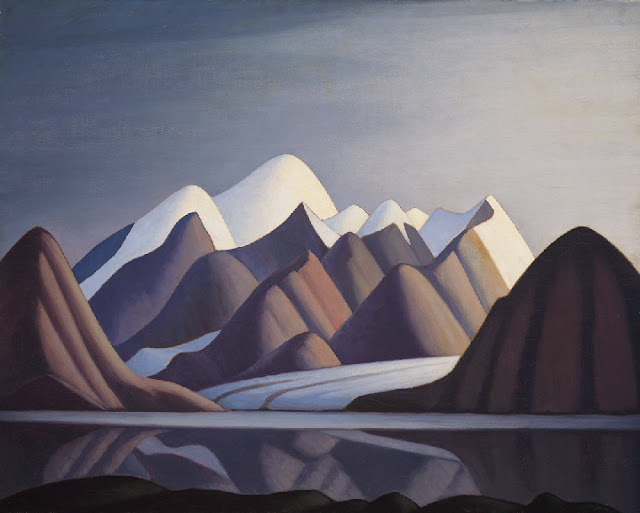CHARLES HAMILTON SMITH (1776-1859)
Mount Saint Elias (5,489 m- 18,008 ft)
United States of America (Alaska) - Canada (Yukon) border
United States of America (Alaska) - Canada (Yukon) border
In Icy Bay & Mount Saint Elias (Alaska,) watercolor and graphite from Views of Polar region-
Yale Center for British arts
The mountain
Mount Saint Elias (5,489 m- 18,008 ft) also designated as Boundary Peak 186 is the second highest mountain in both Canada and the United States, being situated on the Yukon and Alaska border.
It lies about 26 miles (42 km) southwest of Mount Logan, the highest mountain in Canada. The Canadian side is part of Kluane National Park and Reserve, while the U.S. side of the mountain is located within Wrangell-St. Elias National Park and Preserve.
Its name in Tlingit is Yasʼéitʼaa Shaa, meaning "mountain behind Icy Bay", and is occasionally called Shaa Tlein "Big Mountain" by the Yakutat Tlingit. It is one of the most important crests of the Kwaashkʼiḵwáan clan since they used it as a guide during their journey down the Copper River.
The mountain was first sighted by European explorers on July 16, 1741 by Vitus Bering of Russia. While some historians contend that the mountain was named by Bering, others believe that eighteenth century mapmakers named it after Cape Saint Elias, when it was left unnamed by Bering.
Mount Saint Elias is notable for its immense vertical relief vertically in just 10 miles (16 km) horizontal distance from the head of Taan Fjord, off of Icy Bay.
The artist
Lieutenant-Colonel Charles Hamilton Smith, was an English artist, naturalist, antiquary, illustrator, soldier, and... spy as well !. His military career began in 1787, when he studied at the Austrian academy for artillery and engineers at Mechelen and Leuven in Belgium (his native country). Although his military service, which ended in 1820 and included the Napoleonic Wars, saw him travel extensively (including the West Indies, Canada, United States, Southern and Northern Europe and ...Antarctica).
As a prolific self-taught illustrator (over 38,000 drawings!) He left quite an important number of books of beautifully watercolored landscapes taken all around the world. those nooks of watercolors are nowadays in the collections of the Yale Center From British Art. Among them :
Lieutenant-Colonel Charles Hamilton Smith, was an English artist, naturalist, antiquary, illustrator, soldier, and... spy as well !. His military career began in 1787, when he studied at the Austrian academy for artillery and engineers at Mechelen and Leuven in Belgium (his native country). Although his military service, which ended in 1820 and included the Napoleonic Wars, saw him travel extensively (including the West Indies, Canada, United States, Southern and Northern Europe and ...Antarctica).
As a prolific self-taught illustrator (over 38,000 drawings!) He left quite an important number of books of beautifully watercolored landscapes taken all around the world. those nooks of watercolors are nowadays in the collections of the Yale Center From British Art. Among them :
- Views of France, Volume I (81 watercolors), Views of France, Volume II (93 watercolors),
- Views of England and Wales, Volume I (82 watercolors), Views of England and Wales, Volume II (74 watercolors),
- Views of Northern Europe, Volume I (68watercolors) , Views of Northern Europe, Volume II (78) watercolors),
- Views of Polar Regions (75 watercolors) (see above)
- Views of Spain, Volume I (69 watercolors), Views of Spain, Volume II (72 watercolors),
But
one of his noteworthy achievements was an 1800 experiment to determine
which color should be used for military uniforms. He is also known in
military history circles for Costume of the Army of the British Empire, produced towards the end of the Napoleonic Wars and an accurate depiction of contemporary British uniform.
As an antiquarian, he also produced, in collaboration with Samuel Rush Meyrick, Costume of the Original Inhabitants of the British Islands, 1815, and The Ancient Costume of England, with historical illustrations of medieval knights, ladies, shipsm and battles.
He also wrote on the history of the Seven Years' War and TheNatural history of dogs.
Quite a productive fellow !
______________________________________
2019 - Wandering Vertexes...
by Francis Rousseau
______________________________________
2019 - Wandering Vertexes...
by Francis Rousseau



